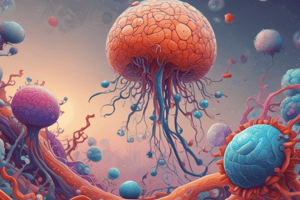Podcast
Questions and Answers
What is the primary function of the mitochondria in a cell?
What is the primary function of the mitochondria in a cell?
- Cell signaling
- Protein synthesis
- Energy generation (correct)
- Waste management
Which type of cell lacks a true nucleus?
Which type of cell lacks a true nucleus?
- Eukaryotic cell
- Prokaryotic cell (correct)
- Muscle cell
- Stem cell
What is the role of the Golgi apparatus in a cell?
What is the role of the Golgi apparatus in a cell?
- Cell signaling
- Protein synthesis
- Energy generation
- Protein modification, sorting, and transport (correct)
What is the term for the process of converting energy and nutrients into the components that make up living organisms?
What is the term for the process of converting energy and nutrients into the components that make up living organisms?
What is the function of lysosomes in a cell?
What is the function of lysosomes in a cell?
Which type of cell is involved in transmitting and processing information?
Which type of cell is involved in transmitting and processing information?
What is the term for the process by which cells respond to changes in their environment?
What is the term for the process by which cells respond to changes in their environment?
What is the function of the endoplasmic reticulum (ER) in a cell?
What is the function of the endoplasmic reticulum (ER) in a cell?
Flashcards are hidden until you start studying
Study Notes
Cell Structure
- Plasma membrane: a thin, semi-permeable membrane that surrounds the cell and regulates what enters and leaves
- Cytoplasm: a jelly-like substance inside the cell where metabolic processes take place
- Nucleus: the control center of the cell where DNA is stored
- Mitochondria: organelles responsible for generating energy for the cell through cellular respiration
- Endoplasmic reticulum (ER): a network of membranous tubules and cisternae involved in protein synthesis, transport, and storage
- Ribosomes: small organelles found throughout the cytoplasm where protein synthesis occurs
- Lysosomes: membrane-bound sacs that contain digestive enzymes and help break down and recycle cellular waste and foreign substances
- Golgi apparatus: a complex of flattened sacs and tubules involved in protein modification, sorting, and transport
Cell Functions
- Metabolism: the process of converting energy and nutrients into the components that make up living organisms
- Growth and development: cells grow, divide, and differentiate to form tissues and organs
- Response to stimuli: cells respond to changes in their environment through signaling pathways and gene expression
- Reproduction: cells divide to produce new cells through mitosis or meiosis
- Defense: cells have mechanisms to defend against pathogens, such as the immune system
Cell Types
- Prokaryotic cells: lack a true nucleus and are typically small and simple in structure (e.g., bacteria)
- Eukaryotic cells: have a true nucleus and are typically larger and more complex in structure (e.g., plants, animals, fungi)
- Stem cells: undifferentiated cells that have the ability to differentiate into specialized cell types
- Epithelial cells: form the lining of tissues and organs and are involved in absorption, secretion, and protection
- Connective tissue cells: provide support, structure, and connectivity to the body
- Muscle cells: specialized for contraction and movement
- Nerve cells (neurons): specialized for transmitting and processing information
Cell Structure
- Plasma membrane is semi-permeable, regulating what enters and leaves the cell
- Cytoplasm is a jelly-like substance where metabolic processes take place
- Nucleus is the control center of the cell, storing DNA
- Mitochondria generate energy for the cell through cellular respiration
- Endoplasmic reticulum (ER) is involved in protein synthesis, transport, and storage
- Ribosomes are found throughout the cytoplasm, synthesizing proteins
- Lysosomes contain digestive enzymes, breaking down and recycling cellular waste and foreign substances
- Golgi apparatus modifies, sorts, and transports proteins
Cell Functions
- Metabolism converts energy and nutrients into living organism components
- Cells grow, divide, and differentiate for growth and development
- Cells respond to environmental changes through signaling pathways and gene expression
- Cell division produces new cells through mitosis or meiosis
- Defense mechanisms protect against pathogens, including the immune system
Cell Types
- Prokaryotic cells lack a true nucleus, are small and simple, and include bacteria
- Eukaryotic cells have a true nucleus, are larger and more complex, and include plants, animals, and fungi
- Stem cells are undifferentiated, able to differentiate into specialized cell types
- Epithelial cells form tissue and organ linings, facilitating absorption, secretion, and protection
- Connective tissue cells provide support, structure, and connectivity to the body
- Muscle cells are specialized for contraction and movement
- Nerve cells (neurons) are specialized for transmitting and processing information
Studying That Suits You
Use AI to generate personalized quizzes and flashcards to suit your learning preferences.




